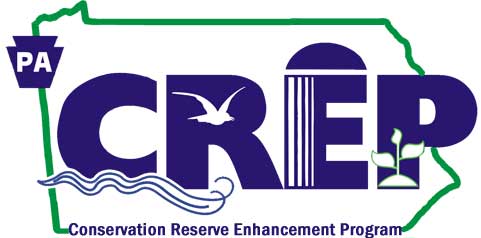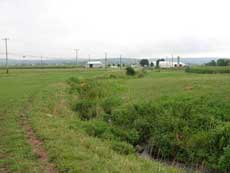|
Ecology of CREP The Conservation Reserve Enhancement Program was developed to accomplish multiple goals. CREP is designed to improve water quality, benefit wildlife through habitat development, and reward participants for doing their part to help the environment. All landowners can apply for CREP! Non-forested land along waterways and highly erodible land (HEL) are target areas for CREP enrollment. Stream health is dependent on many factors in the water and along the banks. Water quality and temperature play an important role in determining what can live in a stream. The trees, shrubs, and plants that grow in this area along the stream, known as a riparian corridor, serve multiple purposes. This vegetation helps control water quality and temperature, and provides abundant habitat for wildlife. Establishment of wetlands and grasslands also play a role in water quality and wildlife habitat. Stream Ecology Impacts
CREP Helps with Water Quality & Wildlife Habitat Development! Riparian corridors, wetlands, and highly erodible lands (HEL) enrolled in CREP are allowed to revert to their natural state, and may be helped along in this process with the planting of native trees, shrubs, plants, and grasses. These “wild”-looking vegetated areas stabilize soil and act as natural filter strips for runoff. Additionally, as the riparian buffer matures, the stream becomes shaded by vegetation, helping control stream water temperature. Through CREP, new wetlands can be constructed in cultivated areas where soil tests indicate that a wetland existed in the past. These wetlands control flooding and wetland plants help remove water contaminants. A unique feature of these areas is that the resulting vegetation is specific to riparian corridors, wetlands, or grassland habitats. Common Vegetation found in Riparian Buffers, Wetlands, and Grassland Habitats*
A variety of wildlife depends on grassland habitats and adjacent riparian areas year-round. Birds use the many layers of vegetation cover (trees, shrubs, and grasses) and plentiful plant species found in these habitats for food and cover. During the breeding season, many ground-nesting bird and mammal species build nests in the vegetation and use the cover to raise and protect their young. In the winter, seeds are foraged and dead vegetation creates pockets where ground-dwelling birds can take shelter. Butterflies, and other beneficial insects, feed on the flowers that grow in the grassland. Unlike the specific vegetation of riparian corridors, wetlands, and grasslands, the wildlife that depend on these areas commonly travel between them for both food and shelter. Possible Wildlife Attracted to Riparian, Wetland, and Grassland Habitats*
*please note: This is not a comprehensive list of wildlife and by no means guarantees the presence or absence of species listed. Enrollment Rewards! Congratulations! You are now taking part in one of the premier conservation programs in Pennsylvania! Not only are you being environmentally friendly to water quality and wildlife habitat, you are being financially compensated for your good deeds. Remember, your responsibilities don’t end with CREP Conservation Practice installation. You must keep your CREP practices in maintain for the entire term of the CREP contract. But don’t worry – if you stay involved during the development of your CREP Conservation Plan and play an active role in understanding your responsibilities, you will be equipped for success! Also, there are many federal, state, and local partners available to help you with the technical details of CREP, from maintaining tree seedling health to caring for newly installed wetlands. By calling the toll-free number at the bottom of this page you can hear a list of the CREP partners and get the phone number for your local CREP contact. More Information
|
||||||||||||||||||||
 |
|

